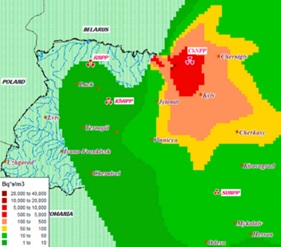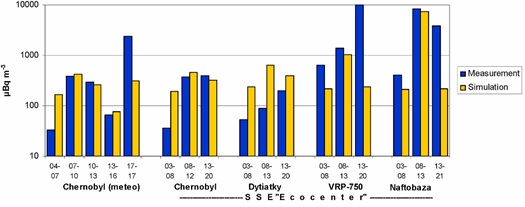Simulation study of radionuclide atmospheric transport after wildland fires in the Chernobyl Exclusion Zone in April 2020
Project Assistant Professor Yasunori Igarashi
Research Overview
Institute for Safety Problems of Nuclear Power Plants (Kiev, Ukrain), Institute of Mathematical Machines and Systems Problems (Kiev, Ukrain), Rivne Nuclear Power Plant (Rivne, Ukrain), and the researchers of the Institute of Environmental Radioactivity (IER) at Fukushima University have been conducting the joint studies of radionuclide atmospheric transport after wildland fires in the Chernobyl Exclusion Zone in April 2020. This research is going within the framework of National Academy of Sciences of Ukraine Foundation (No. 2020.02/0048), and, Japan-Ukraine SATREPS Chernobyl project (funded by JST and JICA, JPMJSA1603) and JSPS KAKENHI Project 18H03389.
In the recent study, we focused on the wildland fires in the Chernobyl exclusion zone and atmospheric transport of radionuclide emissions. The 137Cs air contamination in Ukraine due to the large forest fires in April 2020 was estimated using atmospheric transport modeling (Fig. 1). Total activity of 137Cs emissions during the fires in April 2020 is estimated to be 574 GBq. Total effective dose for adults in Kyiv was estimated to be 5.7 nSv during the fire period, and 30 nSv by the end of 2020. Comparison of measurement data of the 137Cs activity concentration in the surface air at Chernobyl meteorological station and at monitoring sites of SSE “Ecocenter” with simulation results averaged for the corresponding sampling periods (Fig. 2). The emission factor of radioactive aerosols strongly depends on the geographical region, type of vegetation, and land use in the fire area. Thus, the value should be clarified by the further studies of previous fires event and the data from experiments.
Figures


The Significance of the Study
This study conducted (1) the evaluation of the forest fires in April 2020 on the radiation situation within and beyond the Chernobyl exclusion zone, comparing atmospheric transport simulation results with available measurement data, and (2) the rapid estimations of radioactive aerosol emissions from forest fires.
Publication
This study is available online on January 19, 2021.
| Journal | Atmospheric Pollution Research |
|---|---|
| Title | Simulation study of radionuclide atmospheric transport after wildland fires in the Chernobyl Exclusion Zone in April 2020 |
| URL | https://doi.org/10.1016/j.apr.2021.01.010 |
| Authors | Mykola Talerkoaa, Ivan Kovaletsbb, Тatiana Levaa, Yasunori Igarashic, Olexandr Romanenkod *aInstitute for Safety Problems of Nuclear Power Plants, NAS of Ukraine *bInstitute of Mathematical Machines and Systems Problems, NAS of Ukraine *cInstitute of Environmental Radioactivity, Fukushima University *dRivne Nuclear Power Plant |
